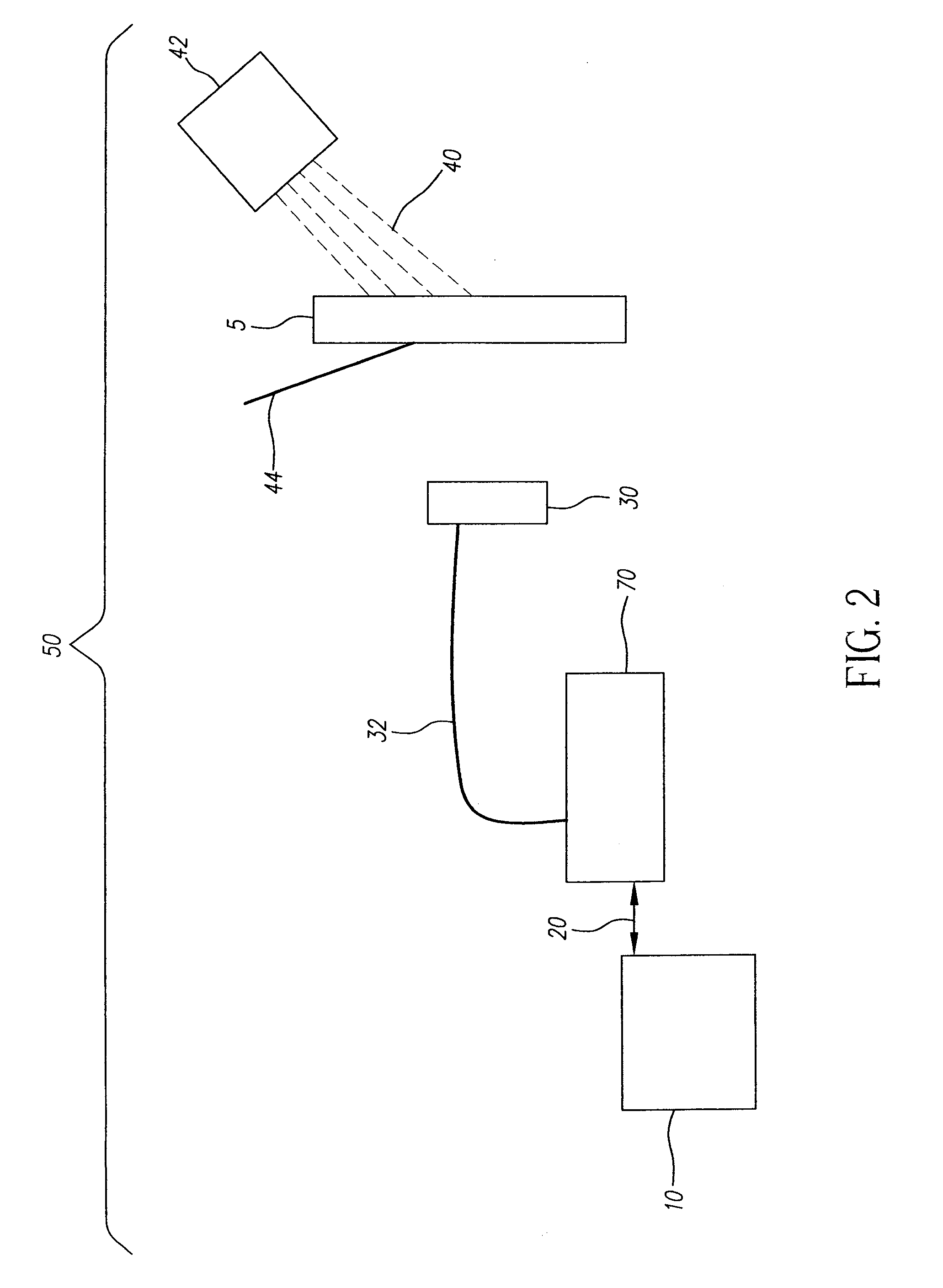Measuring etching rates using low coherence interferometry
a low coherence interferometer and etching rate technology, applied in the direction of fluid pressure measurement, semiconductor/solid-state device testing/measurement, instruments, etc., can solve the problems of complex measurement process, many sensors and mems devices required, device failure,
- Summary
- Abstract
- Description
- Claims
- Application Information
AI Technical Summary
Benefits of technology
Problems solved by technology
Method used
Image
Examples
example 1
[0072]This example shows the effect of temperature on optical thickness measured by low coherence interferometry using the apparatus described in FIG. 8. FIG. 11 shows a graph of measured optical thickness as a function of temperature for a 26.6 mm on a side square coupon (709.7 sq mm) of silicon mounted in the fixture shown in FIGS. 6 and 7. The temperature ramp was 10° C. per hour. The fit of the data shown in FIG. 11 was obtained from a regression analysis of the raw data using the relationship shown in equation (17). The best fit data is n=3.49749, to=694.420 μm, α=4.15E-06 / K and dn / dT=2.37E-04 / K where to is the initial thickness. Since the thermo optic coefficient of silicon is approximately 2 orders of magnitude larger than typical glass substrates when determining etching rates of silicon it is desirable to measure temperature along with thickness to study dissolution effects in real time using low-coherence interferometry.
example 2
[0073]This example shows how low coherence interferometry has been implemented to measure in situ etch rates for a homogeneous material, in this case silicon. A silicon coupon in the 100-orientation (Si(100)) (709.7 sq mm, 0.35 mm thick) polished on both sides was mounted in the fixture shown in FIG. 6, with the fixture mounted in an oven. The position (lateral, vertical, and angular) of the interferometric probe (30 in FIG. 6) was adjusted to obtain signals from the optical interfaces of the silicon. The etching solution (pH 10 buffer obtained from Ricca Chemical Co., experimental pH 10.06) was supplied from a reservoir of etching solution suspended in a constant temperature bath. A recirculation system was used to introduce the etchant into the etching chamber. The recirculation system was comprised of PTFE and stainless steel tubing, a pump and controller, needle valves to regulate pressure and flow, and pressure gauges. In this experiment, the pressure was maintained at atmosphe...
example 3
[0074]This example shows how low coherence interferometry can be used to measure in situ etch rates for a homogeneous material, in this case borosilicate glass. A borosilicate glass coupon (709.7 sq mm, 1.1 mm thick) was mounted the fixture shown in FIG. 6. The etchant was Kodak 1015 Flush Fluid (1015 FF) solution (pH 11.3). Using the recirculation system described in Example 2, the pressure was set to 25 psi, and the temperature of the etching environment was adjusted to 71.0° C. The progress of etching of the borosilicate glass was followed by low coherence interferometry. The optical thickness measurements are shown in FIG. 13. From a linear fit of the in situ monitoring of the optical thickness (fit shown in FIG. 13, slope=23.7 optical nm / h) divided by the refractive index of the glass (1.46), the etch rate was determined to be 16.2 nm / h. After exposure to the etchant for 21.5 h, the borosilicate glass coupon was analyzed by profilometry at the boundary between the glass surface...
PUM
| Property | Measurement | Unit |
|---|---|---|
| temperatures | aaaaa | aaaaa |
| pH | aaaaa | aaaaa |
| coherence length | aaaaa | aaaaa |
Abstract
Description
Claims
Application Information
 Login to View More
Login to View More - R&D
- Intellectual Property
- Life Sciences
- Materials
- Tech Scout
- Unparalleled Data Quality
- Higher Quality Content
- 60% Fewer Hallucinations
Browse by: Latest US Patents, China's latest patents, Technical Efficacy Thesaurus, Application Domain, Technology Topic, Popular Technical Reports.
© 2025 PatSnap. All rights reserved.Legal|Privacy policy|Modern Slavery Act Transparency Statement|Sitemap|About US| Contact US: help@patsnap.com



